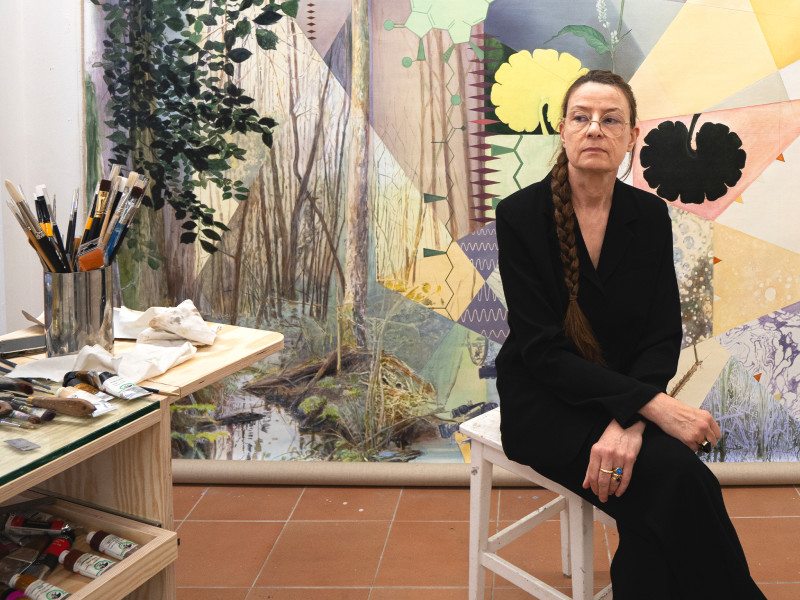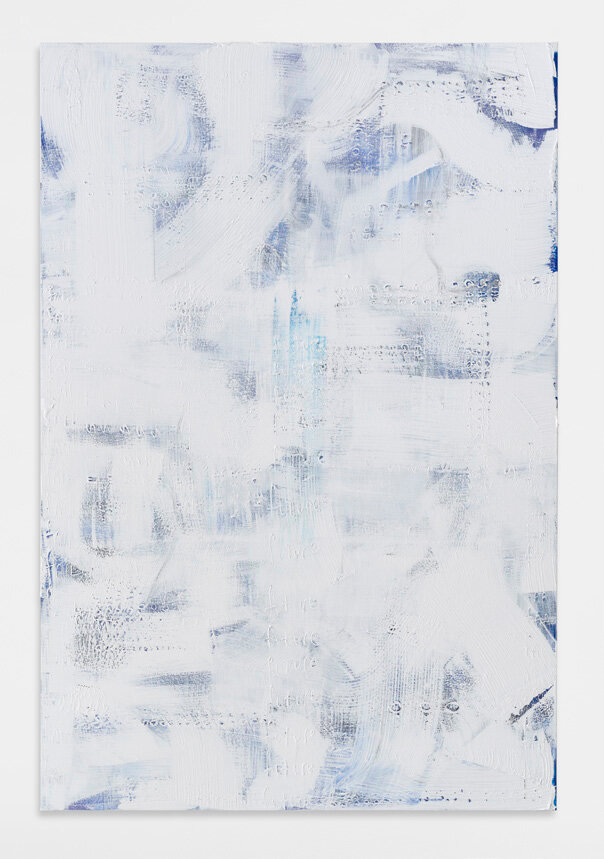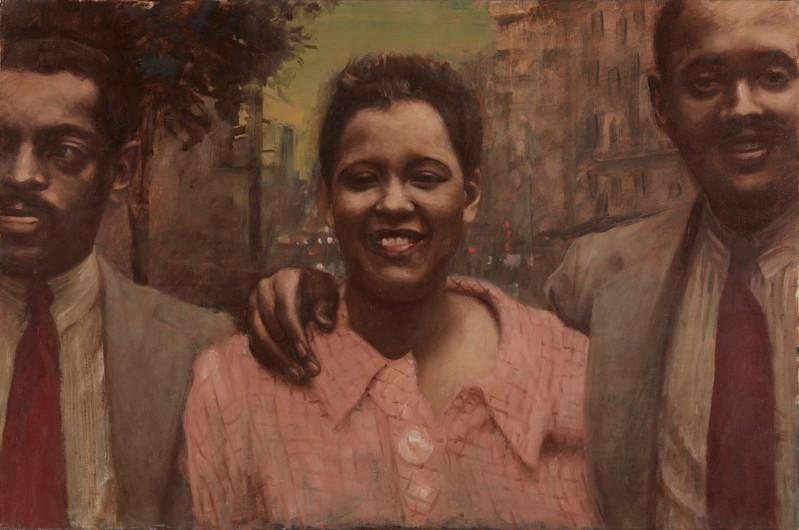Christine Ödlund Into the Swamp by Paulina Sokolow
In Focus
October 23, 2023

(I) The place where there is no boundary between life and death
You want me to land on Earth? Why?
– Because you’re hanging in mid-air, headed for a crash.
– How is it down there?
– Pretty tense.
– A war zone?
– Close: a Critical Zone, a few kilometers thick, where everything happens.
– Is it habitable?
– Depends on your chosen science.
– Will I survive down there?
– Depends on your politics.
Bruno Latour, Critical Zones. The Science and Politics of Landing on Earth, 2020, MIT
The stale scent of something living, a pale, greenish-grey mist hovering over the ground, nature’s seamless transition between a world of water and the exoskeletal bugs in the air. Flies, larvae, gerridae in their flotation shoes, spawn, amphibians. The soft rustle of a frog, a quietly brooding duck who has made a nest in the reeds. Dripping, clucking, rustling. A wet chronicle of life on Earth. Decompositions, gases enriched by juicy hydrocarbons left behind by the flora and fauna of ages past, and, deeper still, an archive of non-degradable materials. Oblations, burial sites, secret caches, and the remains of fallen vertebrates. The swamp reads like a book.
A place that philosopher Bruno Latour referred to as la zone critique, the critical zone. His choice of adjective here subtly defines the state of things, how something is possibly, probably, out of balance, in need of careful oversight. Reflect on this: Is humanity’s place on Earth, or is it here we part ways? Is this the beginning or the end? That depends on whether we factor ourselves into the equation. The swamp can’t answer this question for us, as she is unable to distinguish life from death. Inside her, all that exists is the transition itself, as nothing can die without transitioning into life, whether cell by cell or through photosynthesis. How is the very concept of death even possible if it is a requisite for the continuation of life? Here’s how the swamp keeps her secrets: she makes herself an extremely inhospitable place for humans. Mosquitos, ticks, unfamiliar odours, slimy secretions. And, of course, nothing of any immediate value. No resources to be exploited, nothing that can be inserted into the activities surveyed by economists. “Wasted space” – at best, drainable land to be turned into cities, farmland, or parking spaces. To those who cannot hear the music, who cannot sense the low-frequency vibrations of ever-present birth, the swamp is the paradigm case of a non-place.
(II) Botticelli’s Primavera
There are no less than 500 different identifiable and classifiable plants depicted in Sandro Botticelli’s Primavera. This large painting, which measures just over two by three metres, hangs in one of the rooms of the Uffizi Gallery, the large art museum in Florence. The work wasn’t given the title Primavera (“Spring”) until about a century after its creation, in the 1550s, when art historian Giorgio Vasari wrote about it. By this point, the early Renaissance had given way to the era known as the High Renaissance today. The painting’s twin, The Birth of Venus, is the more famous of the two, perhaps because of its obvious, appealing symmetry, with the woman emerging from the shell in its centre, and the allegorical figures lined up along the flanks. Primavera, on the other hand, is crowded with figures who all display some degree of family resemblance, and who seem to be engaged in some kind of non-verbal communication, their positions arranged in a pattern reminiscent of sheet music. In the Italian kingdoms of the Renaissance, scholars interpreted the world through neoplatonic allegories, in a shared endeavour to translate pre-Christian philosophy and science into Latin and incorporate it into a Christian worldview. The appeal of Botticelli’s brittle, ornamental tempera painting probably doesn’t reside entirely in its billowing lines and the coolly introverted, smiling faces – the mysterious atmosphere probably also plays a part. The scene is full of movement, what with the spiral formation of the three dancing Graces, the fluttering fabric, the male figure – a counterpart to Adam who is picking an orange, seemingly without a care in the world – the blue-grey figure (a biting wind of March) embracing the nymph, Chloris.
Just to the right of the centre is Venus, who is wearing a mundane dress in the style of the time, and in the background, the air between her and the shaded copse of trees creates the illusion of a pair of angel’s wings, or a mandorla of light. The scene is bursting with activity, yet this scene appears more like a silent, frozen moment.
Being a court painter, Botticelli knew of the great historical thinker, and at virtually the same time as he was working on Primavera, one of the most remarkable pieces of Renaissance writing was created: the Oration on the Dignity of Man, (1486). This would be the first text in world history to be banned by the ultimate spiritual authority: the church in Rome. Historians have referred to this discourse as the manifesto of the Renaissance. The author was a man in his twenties, Giovanni Pico della Mirandola. In his work, Pico emphasises the significance of the human quest for knowledge. He writes: “The scabrous and dirty lower worlds he filled with animals of every kind. However, when the work was finished, the Great Artisan desired that there be some creature to think on the plan of his great work, and love its infinite beauty, and stand in awe at its immenseness.” Everything that lives in the universe was already in it, from the lowliest worm to the angels. Therefore, God created humankind, a being with no role of her own in the system, but was granted the ability to learn from what she saw, and to adapt both herself and her world. His idea has been summarised in a concept we know
all too well today: the Anthropocene.
The drama of Primavera has the appearance of a performance on a stage, a landscape undergoing violent change but with somebody pulling the strings.
(III) They Lost Their Glasses
Environmental protest during Let’s Dance
Updated 27 May 2023.
During the final episode of Let’s Dance, activists from the Återställ våtmarker group (“Restore the wetlands”) invaded the dancefloor.
The viewers of TV4 never saw the events on-screen, but the studio audience witnessed a man and a woman running onto the stage during the pasodoble performance of Charlotte Kalla and Tobias Karlsson. The man, who held up a sign with the words “Återställ våtmarker”, received a blow to the head from a camera. The jury would later praise Kalla’s ability to remain calm under pressure.
“What a cool head you have. I’m so impressed,” said Ann Wilson.
However, Charlotte Kalla didn’t end up winning of the show. Instead, Hampus Hedström scored 90 points, beating Kalla’s score of 84.
Both finalists had consistently expressed their gratitude over this opportunity to compete against each other:
“Just getting to compete against Charlotte Kalla, in anything, is a great honour,” says Hampus Hedström.
“I feel incredibly proud to be standing next to Hampus,” Charlotte Kalla responded.
The two activists, along with a third individual involved in the action, were brought in for questioning, according to the Stockholm police’s website.
At present, all three are suspected of vandalism, but what crimes they might eventually be tried for remains undecided. The act of vandalism they committed was pouring paint on the stage.
Source: the Sveriges Television website
(IV) The Tesseract – the impossible space
The word begins with a whisper – Tessssss – and ends more forcefully: act. The word is formed by combining tessera, “small, square piece of stone” with aktis, “ray of light”. The tesseract is also more informatively defined as a “four-dimensional hypercube”, or more specifically a cube in four-dimensional space. On Wikipedia, this impossible geometrical shape is illustrated in two-dimensional animations. I stare at the rotating sides for ages, watching them construct a space I simply can’t fathom. The moment I try to enter it, I find myself ejected. British mathematician Charles Howard Hinton coined this concept to describe a model of a fourth dimension that slices through time and space – turning everything on its head. Numerous science fiction authors have made good use of this idea, and of the way it projects humankind into the universe, making us feel insignificant, but also aware of the fact that we are on an endless journey. In Aniara, Harry Martinson wrote:
Everything looks as if solidified
and frozen to the mount of Everlasting,
like grains of diamond in a crystal sheath
encompassing the very boundlessness
in a massive, radiant hall of utter distance.
Is this another, more poetic, but nonetheless highly precise definition of the essence of the tesseract? It could also be a reference to art’s power to make the inexplicable explicable, the inconceivable conceivable, and the spatially impossible possible.
(V) Four Dimensions of a Swamp
Let us enter the painting.
Its dimensions are four by five metres, making it significantly larger than Botticelli’s masterpiece, to which it is nonetheless obviously connected. Just as a cube relates to a tesseract, and just as Mirandola’s Renaissance manifesto can be traced to Greta Thunberg’s global movement, there is an explicit relationship to be drawn between these two monumental paintings, despite the 541 years that separate them in time. In Four Dimensions of a Swamp, the plants are the protagonists, while the human figures serve as decor. Here, the firm, linear perspective of the Renaissance painter has been abandoned in favour of a prismatic space, in that the image is fragmented into twenty or so logically distributed facets, or, if you prefer, folds. There is no horizon of any kind. Just like the tesseract, it alternates between ejecting the viewer and pulling them into its multitude of scales and varying degrees of abstraction/concretion, pop culture/biology/mathematics/music. Let’s enter it together. More than anything, Christine Ödlund is a contemporary plein air painter. While her predecessors ventured
into semi-tamed nature, and chose subjects like grain fields, ponds, meadows in bloom, and mountainous coasts, in which the sky played a significant role in creating the naturalist effect, Ödlund engages with low-growing vegetation, from up close, where there is no room for the “air” part of plein air. Reeds, vegetation in various stages of decomposition, and reflective surfaces. More reeds. Unlike the plein air painters of old, she delves deeper into the earth. Here, we encounter semi-translucent larvae depictad in another scale, as if viewed through a microscope. Silhouettes of leaves. As if from another dimension, a memory of a historic moment that was reported as an amusing diversion at the time, we see a young boy depicted at the very moment when a heavy camera mount hits his head, and his eyeglasses are thrown through the air. He is suspended in a position from which he will soon fall to the ground. In this dimension, what will break his fall, however, is not the hard dancefloor but a soft, wavy body of water. Thousands of onlookers witnessed this event, both in real time and after the fact. The impact looked brutal. In his hand, he holds a piece of fabric bearing a message we have all seen by now: “Restore the wetlands”. In another facet/dimension, we see his companion, a woman in a printed dress who is pouring yellow powder out on the floor. A fallen hero accompanied by Danaë and the golden rain – although in a different, less allegorical but more tumultuous age. In the painting, she’s standing in a swamp, where the yellow powder has become will-o’-the-wisps, a phenomenon that science has explained as selfigniting pockets of marsh gas that produce a cold flame. The young women who pressed their red hands against the glass that covered the wonderful little Monet painting at Nationalmuseum in Stockholm, a painting that had been on loan from Musée d’Orsay in Paris, have also been included in this universe. It looks as though they are standing in Monet’s flower garden, where they appear to be making hand gestures like those of the angels in early Christian depictions, signifying an act of blessing. Critics suggested that their actions (and those of other climate activists) would end up making art less accessible, as added glass protection and other security would inevitably be installed in front of the precious artworks. Others reminded us that we might soon only be able to experience wild, untamed nature in pictures.
We are distinctly positioned in time and space. The centre of this world is designated by the spindly writing that has been placed at the absolute centre of the monumental painting, in a position approximately corresponding to that of Venus in Botticelli’s work: Uggleviken, where the artist spent time, and which is also near the marsh she has depicted here.
Four spirits hover over this universe.
(VI) Four Portraits
Psychedelic Botanist (I) Annie Besant (1847–1933)
Theosophist and successor to Madame Blavatsky
– Arrested for advocating contraception – Strike organiser – Reformist socialist (Fabianist) –Championed the causes of Indian and Irish self-rule – Leading theosophist –Why I became a Theosophist (1889) –Translation of the Bhagavad Gita (1895) – Feminist –Introduction to Yoga (1907)
Psychedelic Botanist (II) Eva Ekeblad (1724–86)
Countess (née De la Gardie) –Mariedal castle, Västergötland, Stola manor, Lidköping– Estate manager – Friend of Queen Lovisa Ulrika – Defender of peasants beset by bailiffs – At the age of 24, she made spirits from potatoes –Admitted to the Royal Swedish Academy of Sciences as the first-ever female member in 1748.
Psychedelic Botanist (III) Carl Linnaeus (1707–78)
Laid the foundations for modern biological nomenclature – Founded the Royal Swedish Academy of Sciences in 1739 –The father of modern ecology –Suggested sweet wormwood as a treatment for malaria (a treatment that remains valid today) –Systema Naturae, 1735 – The physician of queen Ulrika Eleonora – The word mammalis (mammal) is presumed to have originated in Linnaeus’s advocacy of maternal breastfeeding
–Ennobled in 1761. His coat of arms depicts an egg, signifying nature, which persists and is preserved in ovo.
Psychedelic Botanist (IV) Emanuel Swedenborg (1688–1772)
Spoke to angels and demons as a child –Is ranked among the most important proponents of spiritualism–Dreamed of discovering a theory that might explain the interactions of spirit and matter–In 1735, he published the manuscript de Infinito (“On infinity”), in which he seeks to explain the relationship between the finite and the infinite, and the relationship between the soul and the body. In 1743, he began working on his Regnum animale (The Animal Kingdom), a subject that had not been addressed in any
Swedish books before.



